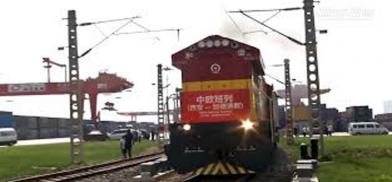New China-Nepal rail corridor is first for South Asia
A new avenue to access transnational markets has opened up for Nepal as freight trains have begun departing from China on a weekly basis with goods destined for Nepal, in an initiative that is said to be the first of its kind in South Asia

A new avenue to access transnational markets has opened up for Nepal as freight trains have begun departing from China on a weekly basis with goods destined for Nepal, in an initiative that is said to be the first of its kind in South Asia.
The first cargo train carrying COVID-19 medical equipment and construction material from Xi’an arrived in Xigatse earlier this week, signalling the activation of the 2016 Nepal-China Transit Transport Agreement signed in the aftermath of the Indian border blockade. Another cargo train with 390 tonnes of goods worth $1.3 million bound for Nepal also arrived in Xigatse from Lanzhou.
Under the TTA, Nepal is granted direct land access to China’s seaports on the eastern seaboard in Tianjin, Shenzhen, Lianyungang and Zhanjiang in addition to land ports in Lhasa, Lanzhou and Xigatse. Experts expect these new corridors to shorten arrival times for international cargo, which currently takes 35 days to get to Kathmandu via Indian ports.
“Transport along the new corridors promise to be time-efficient, and if costs prove to be competitive, our use of Chinese ports for international trade will increase in future,” predicts Nepal’s acting ambassador in Beijing Sushil Lamsal.
The trains take up to ten days from the mainland to Xigatse, and the containers have to be transferred to trucks for the two-day drive across the Tibetan Plateau to the Nepal border at Rasuwa, or a day-and-half to the Kodari checkpoint. However, roads on the Nepal side have still not been properly repaired after damage in the 2015 earthquake and the goods have to be transferred to smaller Nepali lorries.
Experts estimate that costs of shipments through China will be comparable to the maritime route via Indian sea ports. The cost of transporting goods along the Xi’an-Nepal corridor is estimated to be Rs270,000 per container while it costs Rs10,000 less to transport them via Kolkata port. After factoring in the transit times and demurrage costs, however, Nepali traders say they prefer the Chinese rail corridors.
But Rajesh Kaji Shrestha of the Nepal Chamber of Commerce also believes the cost effectiveness of the Chinese route vis-à-vis the sea-land route through India has to be evaluated properly before traders switch.
Others say the ease of transport not just for Nepal’s trade with China but also third countries make the new railway corridor attractive.
Navaraj Dhakal, Joint Secretary of the Bilateral and Regional Trade Division of the Ministry of Industry, Commerce and Supplies says the new route is a test of the TTA with China to facilitate trans-national trade through China.
He adds: “Nepal now has the possibility of accessing transnational trade routes along Chinese ports, seeing that Xi’an is the closest city to the sea ports Nepal is allowed to access under the treaty.”
The road on the Nepal side of the Rasuwa border has still not been fully upgraded after damage during the 2015 earthquake. Photo: SYLVIA CHANG
Besides the infrastructure obstacles on the Nepal side of the Himalayan border with china, the customs procedures are also said to be cumbersome with cartels and corruption hiking up costs.
“Cartelling, middlemen and corruption push per-container costs as high as Rs400,000 from Kerung to Kathmandu,” says Prakash Singh Karki of the Nepal Freight Forwarders’ Association. “That is why for now we prefer the longer Kolkata-based route.”
But if these problems can be solved, Karki is optimistic that the new land route via China will take off, especially after the railway line arrives at Kerung (Gyirong) near the Nepal-China border.
On the Nepal side, there is an urgent need to upgrade the Kathmandu-Rasuwa Highway to smooth all-year operations. Karki adds: “But more than infrastructure, the challenge is to make customs hassle-free and remove the stranglehold of the transport cartels.”
https://www.nepalitimes.com/latest/new-china-nepal-rail-corridor/








Post a Comment